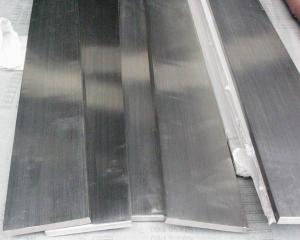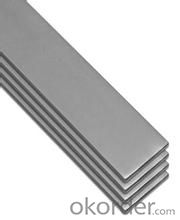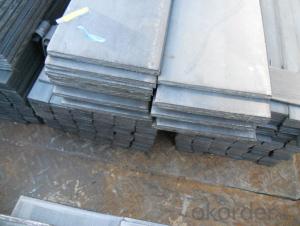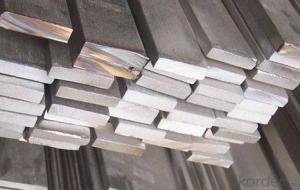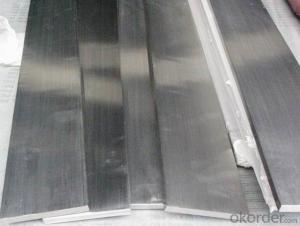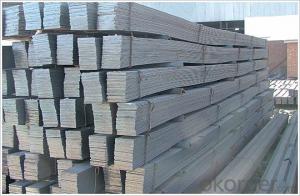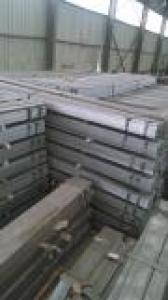Hot Rolled Narrow Flat Steel 20mm*3mm*6m
- Loading Port:
- Tianjin
- Payment Terms:
- TT or LC
- Min Order Qty:
- 25 m.t.
- Supply Capability:
- 10000 m.t./month
OKorder Service Pledge
OKorder Financial Service
You Might Also Like
Product Description:
OKorder is offering Hot Rolled Narrow Flat Steel 20mm*3mm*6m at great prices with worldwide shipping. Our supplier is a world-class manufacturer of steel, with our products utilized the world over. OKorder annually supplies products to European, North American and Asian markets. We provide quotations within 24 hours of receiving an inquiry and guarantee competitive prices.
Product Applications:
Hot Rolled Narrow Flat Steel 20mm*3mm*6m are ideal for structural applications and are widely used in the construction of buildings and bridges, and the manufacturing, petrochemical, and transportation industries.
Product Advantages:
OKorder's Hot Rolled Narrow Flat Steel 20mm*3mm*6m are durable, strong, and resist corrosion.
Product Specifications:
Manufacture: Hot rolled
Grade: Q195 – 235
Certificates: ISO, SGS, BV, CIQ
Length: 6m – 12m, as per customer request
FAQ:
Q1: Why buy Materials & Equipment from OKorder.com?
A1: All products offered byOKorder.com are carefully selected from China's most reliable manufacturing enterprises. Through its ISO certifications, OKorder.com adheres to the highest standards and a commitment to supply chain safety and customer satisfaction.
Q2: How do we guarantee the quality of our products?
A2: We have established an advanced quality management system which conducts strict quality tests at every step, from raw materials to the final product. At the same time, we provide extensive follow-up service assurances as required.
Q3: How soon can we receive the product after purchase?
A3: Within three days of placing an order, we will begin production. The specific shipping date is dependent upon international and government factors, but is typically 7 to 10 workdays.
Q4: What makes stainless steel stainless?
A4: Stainless steel must contain at least 10.5 % chromium. It is this element that reacts with the oxygen in the air to form a complex chrome-oxide surface layer that is invisible but strong enough to prevent further oxygen from "staining" (rusting) the surface. Higher levels of chromium and the addition of other alloying elements such as nickel and molybdenum enhance this surface layer and improve the corrosion resistance of the stainless material.
Q5: Can stainless steel rust?
A5: Stainless does not "rust" as you think of regular steel rusting with a red oxide on the surface that flakes off. If you see red rust it is probably due to some iron particles that have contaminated the surface of the stainless steel and it is these iron particles that are rusting. Look at the source of the rusting and see if you can remove it from the surface.
Images:
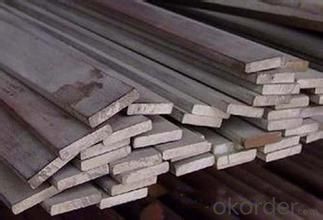
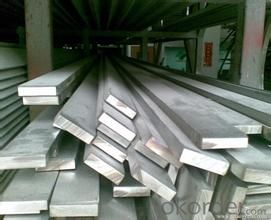
- Q: Are steel flat bars suitable for agricultural applications?
- Indeed, agricultural applications can certainly benefit from the use of steel flat bars. Steel, being an incredibly resilient and robust material, can easily endure the strenuous demands imposed by agricultural activities. These flat bars find utility in a wide array of agricultural applications, including the construction of equipment and machinery, the erection of structures and fences, and even for general repairs and maintenance tasks. With their exceptional strength and stability, steel flat bars exhibit the capability to withstand heavy loads and the harshest weather conditions. Moreover, their versatility allows for easy shaping and welding, thus permitting customization to meet specific requirements. Ultimately, when it comes to agricultural applications, steel flat bars present themselves as a dependable and enduring choice.
- Q: How do steel flat bars contribute to the overall sustainability of structures?
- Steel flat bars contribute to the overall sustainability of structures in several ways. Firstly, they are made from recycled materials, reducing the demand for new resources and minimizing the environmental impact of extraction and production. Additionally, steel flat bars offer high strength and durability, ensuring the longevity of structures and reducing the need for frequent replacements or repairs. Their versatility allows for efficient use in various applications, optimizing material utilization and minimizing waste. Furthermore, steel is highly recyclable, meaning that at the end of a structure's life cycle, the steel flat bars can be easily recycled and repurposed, reducing landfill waste. Overall, the use of steel flat bars in structures enhances sustainability through resource conservation, durability, and recyclability.
- Q: The difference between galvanized flat steel 40*4 and galvanized flat steel 80*8 is the difference on the material list!
- Here, your galvanized flat steel refers to the basic matrix is carbon content less than 0.18% carbon steel (Q235), after galvanizing (general hot plating), play the role of surface oxidation resistance, corrosion resistance. Generally used in the power sector, what you mention is the difference in size.
- Q: Are steel flat bars suitable for food processing or hygiene-sensitive environments?
- Steel flat bars are generally not suitable for food processing or hygiene-sensitive environments. Despite being strong and durable, steel is not naturally resistant to corrosion or contamination. In such environments, it is typically advised to use stainless steel instead. Stainless steel has a higher chromium content, which forms a protective layer on the metal's surface, preventing corrosion, staining, and bacterial growth. Therefore, stainless steel is a more appropriate option for applications where cleanliness and hygiene are crucial.
- Q: What are the benefits of using steel flat bars in architectural projects?
- There are several benefits of using steel flat bars in architectural projects. Firstly, steel flat bars offer high tensile strength and exceptional durability, making them suitable for supporting heavy loads and withstanding harsh weather conditions. Secondly, their versatility allows for various applications such as framing, support structures, and decorative elements. Additionally, steel flat bars are malleable, making it easier to shape and customize according to specific project requirements. Moreover, steel's corrosion resistance minimizes the need for regular maintenance and ensures long-term performance. Lastly, steel is a sustainable and environmentally friendly material, as it can be recycled indefinitely without losing its properties, reducing the overall environmental impact of architectural projects.
- Q: What are the different methods of surface hammering for steel flat bars?
- Steel flat bars can be surface hammered using several methods, each with its own characteristics and applications. These methods aim to enhance the aesthetic appeal and functionality of the bars by creating different textures and patterns. Planishing is a technique that involves using a planishing hammer or mallet to strike the steel bar repeatedly. The blows are carefully controlled and overlapping, resulting in a smooth and uniform texture. This method is commonly used for decorative purposes, creating a polished and reflective surface on the bars. Peening is another method where the steel bar is struck with a ball-peen hammer or similar tool. This creates small indentations on the surface, giving it a textured appearance. Peening is often used to improve the grip and traction of the bars, making them suitable for applications where slip resistance is important. Cross-peening is a variation of peening where the hammer strikes the steel bar at an angle, creating crossed indentations. This technique increases the strength and durability of the bar by distributing stress more evenly. Raising is a method used to shape steel flat bars into three-dimensional forms. It involves hammering the bar against a curved surface, gradually shaping it into the desired contour. Raising can be used to create curved shapes like bowls or cups from flat bars. Chasing is a technique where specialized chasing tools are used to hammer patterns or designs onto the surface of the bar. Different tools with various shapes and sizes allow for intricate and detailed designs. Chasing is commonly used in ornamental metalwork to add decorative elements. Texturing involves using tools like a texturing hammer or stamp to create specific textures or patterns on the surface of the bars. This method offers a wide range of effects, from dimples and ridges to a hammered or brushed appearance. Texturing adds visual interest and can improve the grip of the bars. In conclusion, these methods of surface hammering for steel flat bars provide flexibility and versatility in terms of texture, pattern, and functionality. They allow for customization and innovation in various applications, from decorative metalwork to industrial and architectural uses.
- Q: Are steel flat bars suitable for indoor applications?
- Yes, steel flat bars are suitable for indoor applications. Steel flat bars are versatile and highly durable, making them ideal for various indoor uses. They can be used in construction, manufacturing, and furniture making, among other applications. Steel flat bars offer excellent strength and stability, making them suitable for supporting heavy loads or providing structural reinforcement. Additionally, they are resistant to corrosion and can withstand harsh indoor environments. Steel flat bars can be easily customized and fabricated to meet specific project requirements, making them a popular choice for indoor applications.
- Q: Can steel flat bars be used in corrosive environments?
- No, steel flat bars are not recommended for use in corrosive environments as they are susceptible to rust and corrosion.
- Q: What are the common surface treatments for steel flat bars?
- Steel flat bars can undergo various surface treatments to improve their appearance, durability, and resistance to corrosion. The most common treatments are as follows: 1. Hot-dip galvanizing immerses the bars in molten zinc, creating a protective coating that enhances their lifespan and corrosion resistance. 2. Powder coating involves applying a dry powder to the bars and heating it to create a long-lasting finish. This treatment offers a wide range of colors and excellent resistance to scratching, chipping, and fading. 3. Electroplating deposits a thin layer of metal, such as zinc, nickel, or chrome, onto the bars using electricity. It improves their appearance, corrosion resistance, and can provide a decorative finish. 4. Painting applies a layer of paint to the bars for both aesthetic appeal and protection against corrosion. Different types of paints, such as epoxy, polyurethane, and enamel, can be used depending on specific requirements. 5. Anodizing, mainly used for aluminum but can also be applied to steel flat bars, involves creating an oxide layer through electrolysis. This enhances corrosion resistance and provides a decorative finish. These surface treatments are widely used in industries like construction, automotive, manufacturing, and infrastructure projects. The choice of treatment depends on specific application requirements, such as desired aesthetics, durability, and corrosion resistance.
- Q: What are the different types of edges available for steel flat bars?
- There are several types of edges available for steel flat bars, including square edge, round edge, chamfered edge, and beveled edge.
Send your message to us
Hot Rolled Narrow Flat Steel 20mm*3mm*6m
- Loading Port:
- Tianjin
- Payment Terms:
- TT or LC
- Min Order Qty:
- 25 m.t.
- Supply Capability:
- 10000 m.t./month
OKorder Service Pledge
OKorder Financial Service
Similar products
Hot products
Hot Searches
Related keywords
